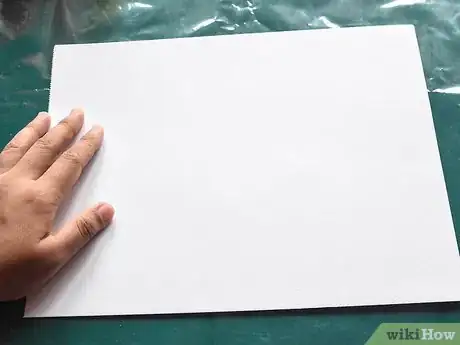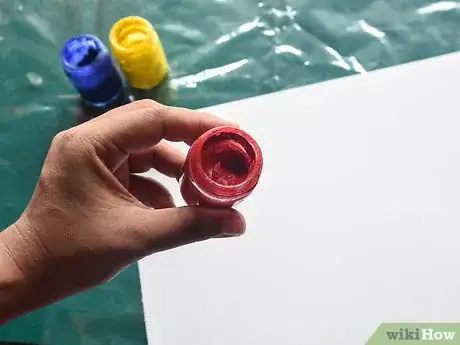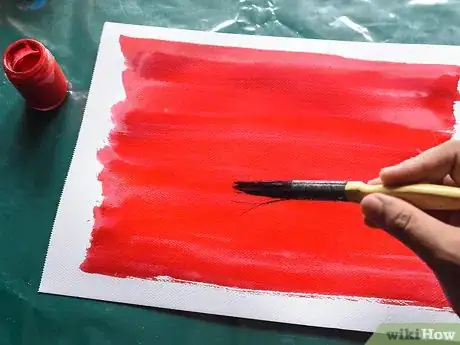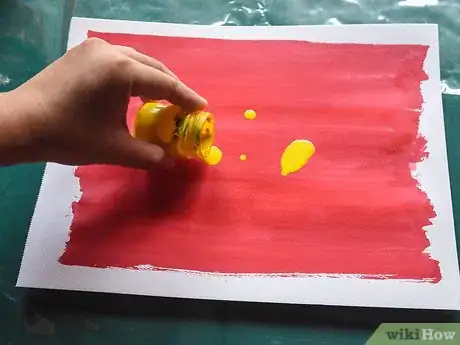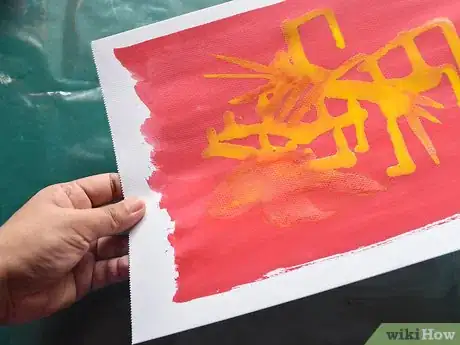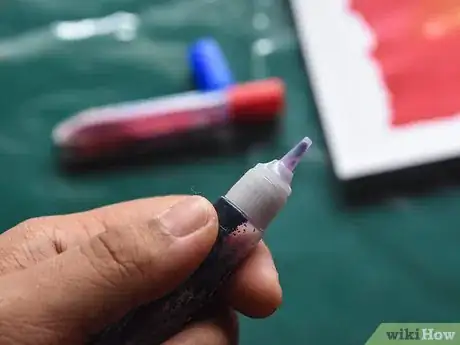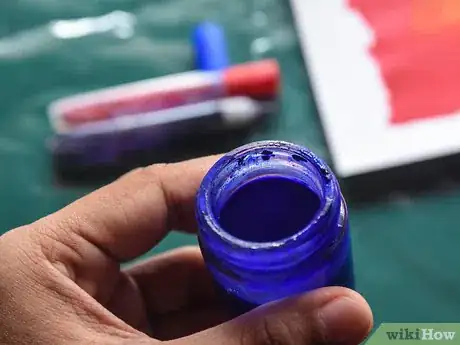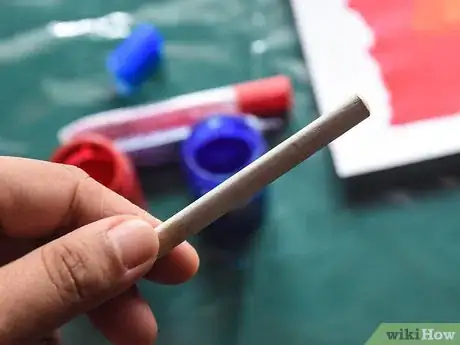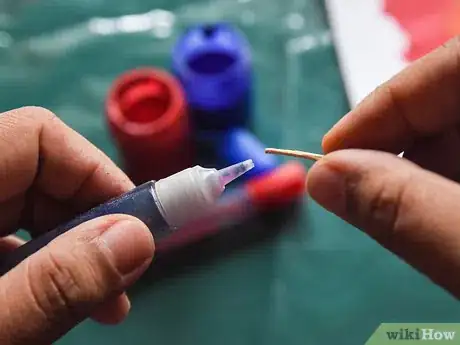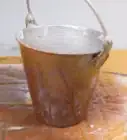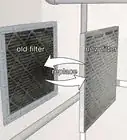This article was co-authored by Laura M. Johnson. Laura M. Johnson is a Mural Artist and the Owner of Laura Margo Murals & Custom Art in St. Paul, Minnesota. She has over five years of experience in the industry and has worked professionally across venture capital, communications, the arts, and beyond. She helps empower small and growing businesses to find their voices, share their stories, and grow their impact. Laura received her Master of Business Administration from the University of Minnesota - Carlson School of Management, and her Bachelors in Journalism and Communication Studies with a minor in Fine Arts from the University of Oregon.
There are 8 references cited in this article, which can be found at the bottom of the page.
This article has been viewed 65,618 times.
Fluid painting is a fun art technique that uses thin paints to create one of a kind pieces without traditional brushwork. Paint is applied to a canvas by pouring, sprinkling, or other dynamic methods. Before you try fluid painting, prepare a clean work space and set up your materials. Test out paints, tools, and techniques beforehand to get a sense of what you want to do. Use your creativity to choose how you will disperse fluid paint onto the canvas, move it, and create your final design. To customize the experience, mix your own fluid paints instead of simply buying them at an art store.
Steps
Organizing Your Workspace
-
1Clean the work surface and cover it with plastic sheeting. It’s important to clean your work space before painting as dust and dirt can easily settle into slow-drying fluid paint. Sweep or vacuum the floor or tabletop that you will be placing your canvas on. Cover the surface with clean plastic sheeting to protect it from stains, and to prevent your artwork from sticking to it.[1]
-
2Set up your materials. The best choice of canvas for fluid painting is a sealed panel, which can handle the weight of fluid acrylics better than a traditional canvas. Set up your canvas and place your paints within arm’s reach of it. Lay out any spreading tools that you may use to disperse paint.[2]
- You can purchase paint and spreading tools at an art supply store.
- Use a "soft body" or "fluid" acrylic paint for best results.
- You can also mix acrylics in water to change their viscosity (thickness) and make them even more fluid. To thin acrylic paints, add water gradually (don't add too fast or too much, as you don't want the paints to be too watery).
- If you are using oils, you may thin them using a linseed oil or odorless mineral spirits (again, mix in slowly).
Advertisement -
3Test your paints and tools. Before embarking on a large fluid painting project, test out your paints and tools on a small, spare canvas to see what effects they produce. Different spreading tools (e.g., palette knives or trowels) may leave unique marks on the paint, and paints may react with each other in different ways given their pigment concentration, finish (e.g. matte, glossy), and density. Observe how the paint looks after letting it dry for several days.[3]
Applying Fluid Paint to the Canvas
-
1Set up the angle of your canvas. If you wish to have full control of how fluid paint is dispersed onto your canvas, place it perfectly flat on your work surface. If you are aiming for a specific dripping effect, place the canvas upright or at an angle. Use an easel or prop the canvas up with something solid (e.g., a large piece of wood) to achieve the angle you want.[4]
-
2Add a toned ground to your canvas. Before starting your fluid painting, consider painting your plain canvas with one solid paint color (or “toned ground”) to make the end result look more professional. Use regular acrylic paint in an opaque color for this. Dip a large brush in the paint and cover the canvas in broad strokes from left to right, aiming to make the paint as smooth as possible.[5]
- Let the canvas sit for 2-3 hours to dry before applying fluid paint to it.
-
3Begin transferring paint to the canvas. How paint disperses onto the canvas will depend on the method of application you use, the vessel you transfer it from, and the angle and distance at which you apply it. Most store-bought fluid paint is sold in squeeze bottles with small nozzles that allow you to dispense it in fine lines, but you can transfer the paint to any container you choose to create your artwork. Some techniques for getting fluid paint onto a canvas include:[6]
- Pouring (applying a generous stream of paint to the canvas)
- Drizzling (pouring very light stream of paint onto the canvas)
- Dropping (e.g., from an eye-dropper)
- Puddling (Applying a puddle of paint to the canvas and letting it seep over it)
- Splashing (Projecting paint onto the canvas with enough force to bounce back off of it)
-
4Spread the paint with your tools as desired. Depending on the design you wish to achieve, you can use spreading tools or a dry paintbrush to disperse fluid paint across your canvas. To ensure greater control, spread or move paint very lightly in multiple, thin coats. Have an empty container or basin on hand to collect excess paint from the canvas, if necessary, using a clean spreading tool.[7]
- Make sure that your tools are perfectly clean before you start painting.Tools should always be cleaned with warm water and hand soap immediately after use, before paint dries on them.[8]
-
5Dry your canvas between coats. Fluid paint is a very wet medium and requires more drying time than other paints. If you wish to layer paint designs over other work on the canvas, allow one to three days between coats so that the layers can dry thoroughly. Painting over other fluid paint that hasn’t dried completely can cause cracks or fissures on the surface of the paint.[9]
Making Your Own Fluid Paint
-
1Choose containers for your paint. Look for clear, squeezable containers that will allow you to see the color of your paint and disperse it easily. Squeeze bottles with a nozzle cap (available at craft stores or online) are the most versatile choice for fluid painting. Purchase the bottles in appropriate sizes for the amount of paint you will be making.[10]
-
2Mix acrylic paint, acrylic medium and water in a squeeze bottle. To make fluid paint, fill each bottle halfway full with the acrylic paint of your choice (available at art supply stores). Fill the remaining half of the bottle with equal parts water and acrylic medium (e.g., glazing liquid, also available at art supply stores). Be sure to keep this ratio of paint to water/acrylic medium, as further diluting the paint may diminish its ability to adhere to the surface being painted.[11]
- Opt for artist grade acrylic paint, which has a higher concentration of pigment than student grade paint.[12]
-
3Mix together the paint. Use a coffee stir stick or a small straw to stir the paint without adding air bubbles to it. You can also add a small ball bearing to the container to help with mixing. Make sure that the paint is thoroughly mixed to avoid clumps or uneven coverage.[13]
-
4Store the paint. After making or using the paint, clean the nozzle and poke the tip with a pin or toothpick to prevent clogging. Ensure that your paint doesn't dry out by unscrewing the nozzle cap and placing a small square of cling wrap onto the opening. Re-cover it tightly.[14]
- As a general rule, paint should not be kept for more than two years.[15]
- Paint should be stored in a cool, dry place, but should not be allowed to freeze.
Community Q&A
-
QuestionWhat should I do if I want to add silicone?
 *EMOTIC*city^^Community AnswerWhen adding silicone, you should add only 2-3 drops for a small to medium sized canvas. You don't have to do anything to the silicone except add the drops to the mixture. (You can also stir the mixture slightly, but that is optional.)
*EMOTIC*city^^Community AnswerWhen adding silicone, you should add only 2-3 drops for a small to medium sized canvas. You don't have to do anything to the silicone except add the drops to the mixture. (You can also stir the mixture slightly, but that is optional.)
Things You'll Need
- A broom or vacuum
- Plastic sheeting
- Sealed canvases
- Acrylic paint
- Acrylic medium
- Paint brushes
- Spreading tools
- Containers
- Stir sticks
References
- ↑ http://www.justpaint.org/understanding-the-techniques-of-pouring-acrylics/
- ↑ http://www.justpaint.org/understanding-the-techniques-of-pouring-acrylics/
- ↑ http://www.justpaint.org/understanding-the-techniques-of-pouring-acrylics/
- ↑ https://www.thoughtco.com/pouring-acrylic-paint-2577360
- ↑ http://willkempartschool.com/how-a-canvas-can-drastically-improve-your-painting/
- ↑ https://www.thoughtco.com/pouring-acrylic-paint-2577360
- ↑ http://www.justpaint.org/understanding-the-techniques-of-pouring-acrylics/
- ↑ https://www.art-is-fun.com/how-to-clean-paintbrushes
- ↑ http://www.justpaint.org/understanding-the-techniques-of-pouring-acrylics/
- ↑ https://www.thoughtco.com/how-to-make-your-own-fluid-acrylics-2577376
- ↑ https://www.thoughtco.com/how-to-make-your-own-fluid-acrylics-2577376
- ↑ https://www.art-is-fun.com/acrylic-paint/
- ↑ https://www.thoughtco.com/how-to-make-your-own-fluid-acrylics-2577376
- ↑ https://www.thoughtco.com/how-to-make-your-own-fluid-acrylics-2577376
- ↑ https://kromaacrylics.com/pages/contact-us

